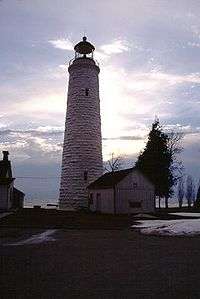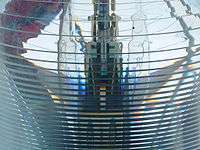Imperial Towers

The Imperial Towers were six of the earliest lighthouses built on Lake Huron by the Canadian government. The designation Imperial is not certain, but historians speculate that because the towers were public construction built under the colonial administration while Canada was a self-governing colony of Britain , the name would assure funding from the British Empire's Board of Trade. (Sapulski, Crompton).
History
In 1855 the Board of Works contracted with John Brown, a builder from Thorold, Ontario, to build eleven lighthouses and dwellings lighting Lake Huron and Georgian Bay between Point Clark and Christian Bay. In the event, only six of the towers were completed. These were:
- Point Clark Lighthouse 44°04′22″N 81°45′26″W / 44.07281°N 81.75731°W
- Chantry Island Lightstation Tower 44°29′22″N 81°24′07″W / 44.48938°N 81.40194°W
- Cove Island Light 45°19′37″N 81°44′06″W / 45.32699°N 81.73505°W
- Nottawasaga Island Light 44°32′12″N 80°15′25″W / 44.53656°N 80.25702°W
- Griffith Island Light 44°51′02″N 80°53′29″W / 44.85058°N 80.89137°W
- Christian Island Light 44°47′12″N 80°09′22″W / 44.78664°N 80.15607°W
All six were built between 1855 and 1859; for the most part, their construction was simultaneous. Cove Island was the first to be lit, on October 30, 1858; Christian Island, the first to be completed but the last to be lit, began work on May 1, 1859.
The locations of the towers were chosen based on known traffic patterns; each tower marked a prominent navigational hazard which was already well-recognized. Sites were also chosen based on their proximity to good anchorages.
Construction
Construction of the lights was plagued by difficulties. Brown lost four full supply boats, all of which sank before reaching their destinations and unloading. More supplies were lost from being swept overboard during storms and rough seas. Furthermore, delivery of the lighting apparatus for each tower was delayed by competing demand from lighthouse expansion in the United States and a bottleneck in the delivery of the French lenses. Consequently, Brown was facing bankruptcy by 1857, and petitioned the provincial government for assistance. The government responded favorably, and by 1859 all six towers were lit.
Description

The six lighthouses and dwellings are basically identical, with minor variations in the design keyed to the different building sites. Five of the towers are 80 feet tall; that at Christian Island is 55 feet. The rock courses at the bottom of the towers reach some seven feet thick, and the walls at ground level are six feet thick, tapering towards two feet thickness at the top. Though the lighthouses are conical, their interior diameter is 10'6'' throughout.
The towers and dwellings are constructed of limestone, with granite added to the towers to support the lantern rooms. The lanterns are made of copper alloys, glass, and cast iron.
The towers are whitewashed and painted with red trim. Each was initially equipped with a Fresnel lens; they were the first Canadian lighthouses so equipped.
As of 2016, all six towers are still standing. However, Griffith, Christian and especially Nottawasaga are deteriorating due to lack of maintenance and in danger.
Sources
- Sapulski, W.; The Imperial Towers of Lake Huron and Georgian Bay
- Berger, T. & Dempster, D.; Lighthouses of the Great Lakes; Voyageur 2002
- Crompton, W. & Rhein, M. The Ultimate Book of Lighthouses; Thunder Bay 2003
- Weaver, H.; John Brown's Imperial Towers: End of an Era; Inland Sea; 1992